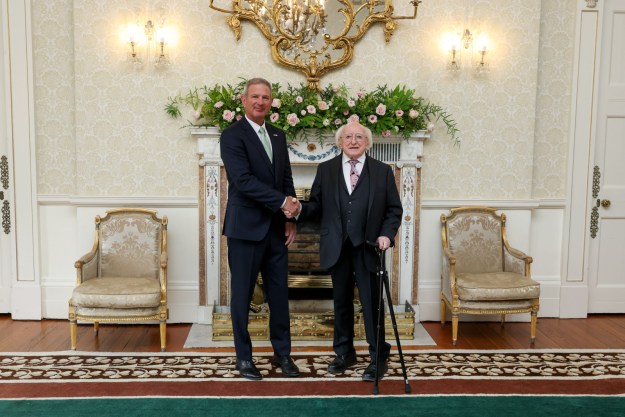UPDATE:
Read or listen to this Democracy Now! interview with Annette Gordon-Reed, a Harvard history professor and president of the Organization of American Historians.
ORIGINAL POST:
The Trump administration announced August 12 that it would begin a comprehensive review of current and planned exhibitions at the Smithsonian Institution, which describes itself as “the world’s largest museum, education, and research complex.” The administration said that it will examine museum display text and website and social media content “to assess tone, historical framing and alignment with American ideals.”
This is part of a broader effort by US President Donald Trump to stamp his gilded, white-washed view of American history on the nation’s 250th anniversary in 2026, and beyond. Earlier this year the Smithsonian removed, then revised, references to Trump’s two impeachments. Historians are alarmed.
Of course, Ireland and the Irish loom large in American history. Several signatories of the Declaration of Independence were born in Ireland or had Irish roots. Mass Irish immigration in the mid-nineteenth century provided soldiers for the US Civil War and labor for American commerce. Ireland’s struggles for freedom and equality have influenced American politics and culture throughout the twentieth century; from helping to scuttle the League of Nations in 1919 to the Good Friday Agreement in 1998, with many St. Patrick’s Day parades in between.
The Smithsonian holds numerous objects and artifacts related to Irish American history. Some have been displayed in public, others featured in institution publications and platforms.
The all-time most viewed post on this site was inspired in 2017 by a display about immigration at the Smithsonian’s National Museum of American History. The “Irish radicalism” addressed in the 1889 political cartoon seen below has been widely discussed by other online platforms, which probably has something to do with the digital traffic. I am not sure if the display I viewed eight years ago is still at the museum, and if so, whether it will survive the Trump scrub.
Another item from the Smithsonian’s website details an 1882 banner honoring Irish American boxer John L. Sullivan. The April 2018 post notes the history of sports figures who wade into politics, including contemporary athletes who refused “to visit the Obama and Trump White Houses.” How will the Trumpistorians deal with this description:
“The Irish were never held as slaves in America, but into the late 1800s Irish Americans continued to battle long-standing prejudices that led many people to think of them as inferior to other European Americans. British and American writers blamed Irish people themselves rather than imperialism and bigotry for Irish poverty. They cited Irish allegiance to the Catholic Church, unsupported applications of Darwin’s theory of evolution, and the pseudoscience of phrenology—which wrongly claimed a link between people’s intellectual potential and the outline of their heads—to claim that Irish people were less independent and less intelligent than “Anglo-Teutonic” people from Northern Europe. Often, as the illustrations below demonstrate, the alleged differences were described in racial terms, with the Irish either not considered white or considered less human than other whites.”
The post goes on to explore Sullivan’s “empathy for the South in the wake of the Civil War and his desire to see the South and North reconciled in a nation that valued white supremacy.” Will the Trumpistorians remove the references to slavery and phrenology but keep the part about white supremacy?
Here’s a March 2015 post that details “four objects that reveal facets of the Irish American experience.” The opening section about early twentieth century St. Patrick’s Day postcards says that many were based on “unflattering stereotypes of the Irish as drinkers, fighters, or simple country bumpkins.” It says that Irish Americans used “protests, boycotts, and calls for the police to confiscate the ‘indecent literature’” as an example of how “both individuals and groups often use whatever power and resources they have at their disposal to push back.”
Was this “cancel culture?” Will the Trumpistorians allow content that speaks about protesting commercial interests, let alone an unpopular government?
These are just three examples. I imagine content that names Trump, such as the second item in this post (Obama and Trump in the same sentence, oh my!), will receive the most immediate attention. Trump seems to have a conflicted relationship with Ireland. He owns a golf course in Clare and has an affinity for Conor McGregor (both convicted in civil courts of sexual misconduct). But Trump has targeted Ireland’s tax schemes and High Tech and Big Pharma infrastructure in his overhaul of global trade, and he doesn’t care for its support of the Palestinians.
I’ll be watching this story over the coming year. I invite readers to send other examples from the Smithsonian or other institutions that could face Trump’s revisionism on Irish issues. And, of course, you are very welcome to visit the Smithsonian museums here in the city of Washington, D.C., now occupied by Trump’s troops.

















